If you’re looking to foster creativity, imagination, and independent play in your child, look no further than a Waldorf playstand. Steeped in the time-tested philosophy of Waldorf education, these simple yet enchanting pieces of furniture are more than meets the eye.
Whether your child is setting up a pretend grocery store, performing a puppet show, or creating a cozy reading nook, a Waldorf playstand can make it possible.
We’re here to review and share what we love about Waldorf playstands and why one might just be the perfect addition to your house or child’s playroom!
In this post:
- What is a Waldorf Playstand?
- What is the Waldorf Philosophy?
- How do You Use a Waldorf Playstand?
- Top Waldorf Playstands
- Buying Considerations
- Waldorf Playstand Accessories
- FAQs
- Final Thoughts on Waldorf Playstands
We get commissions for purchases made through links in this post. As an Amazon Associate, we earn from qualifying purchases.

Learn More!
Fostering Independent Play: Mini Course
The COMPLETE how-to guide for parents on why, when, and how to encourage independent play.
On-demand course broken down into 17 easy-to-digest video lessons, 5 PDF guides, & an online discussion board.
What is a Waldorf Playstand?
A Waldorf playstand is a versatile piece of children’s furniture, often made from wood, which is rooted in the Waldorf education philosophy. This simple yet engaging playstand is typically characterized by a main stand, a secondary shelf underneath the stand, and a top canopy, which collectively offer a variety of open-ended play scenarios.
The two stands and the arch create a cozy nook where kids love to hang out and play alone or with friends.
The design encourages creativity, imagination, and independent play in children. Whether transformed into a store, a home, a puppet theater, a tree block play area, or a cozy reading nook, the possibilities of a Waldorf playstand are limited only by a child’s imagination.
- Looking for other open-ended creative toys? Check out our favorite sets of blocks!
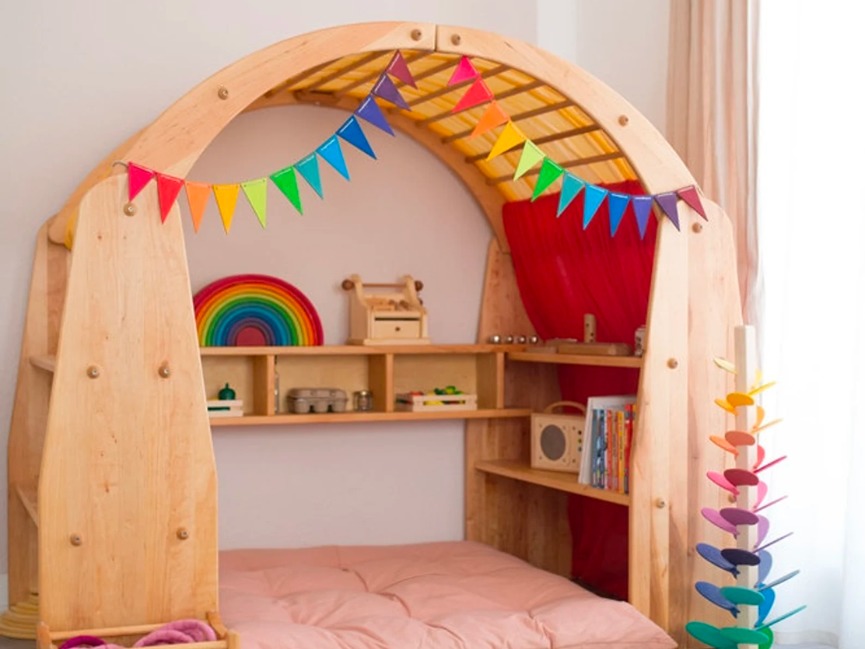
What is the Waldorf Philosophy?
The Waldorf philosophy is an educational approach developed by Rudolf Steiner, an Austrian philosopher, in the early 20th century. It emphasizes the role of imagination in learning and aims to holistically integrate the intellectual, practical, and artistic development of pupils.
Central to this philosophy is the belief that learning should resonate with the child’s developmental stages and respect their individuality.
Waldorf education fosters creativity, critical thinking, and empathy, preparing children for a rapidly changing and connected world. Natural materials are favored in toys and learning materials, with the aim of connecting children with nature and the physical world around them.
- Looking to create a calm space with fewer toys? Learn how to declutter toys!
How Do You Use a Waldorf Playstand?
The beauty of a Waldorf playstand lies in its adaptability and open-ended nature. It is not overly specific, so can be used in endless ways.
Here are a few ways that our kids and students love to use the Waldorf playstand:
Home Corner: Children can set it up as a home corner, draping it with fabrics to create walls and doors. It can be a kitchen, a bedroom, or a living room, offering countless role-play scenarios.
Puppet Theater: With a few adjustments, the playstand can become a puppet theater, encouraging children to put on shows and express themselves creatively.
Shop: The shelves and canopy provide the perfect setup for a store or market stall. Kids can pretend to sell toys, books, or handmade items, boosting their communication and social skills.
Quiet Space: The playstand can also provide a quiet, cozy space for reading or resting. Add some cushions and a soft blanket, and it becomes the perfect sanctuary for a little downtime.
The key is to refrain from directing kids and to allow them to use their own imaginations to create play scenarios. Children are creative enough all on their own!
Top Waldorf Playstands
Now let’s explore some Waldorf playstands available on the market. Here are six of our favorite options. All are high quality, so pick the design that speaks to you!
Elves and Angels Hardwood Waldorf Playstands
This handmade playstand is a beautiful pair of solid hardwood stands, perfect for any playroom or living room. Crafted from durable hardwood, this playstand is made to stand up to lots of play. The two playstands can be moved closer or farther from one another to change the size of the play space.
Each half of the playstand features two shelves and a sturdy design, making them perfect for holding lots of toys. The natural wood finish keeps the design simple and adaptable to any room or house’s decor.
You have the option to add a silk scarf and play clips to make it a ready-for-play set!
What we love:
the double shelves
the beautiful shape of the stands
- easy to set up
Camden Rose Large Eco Playstand
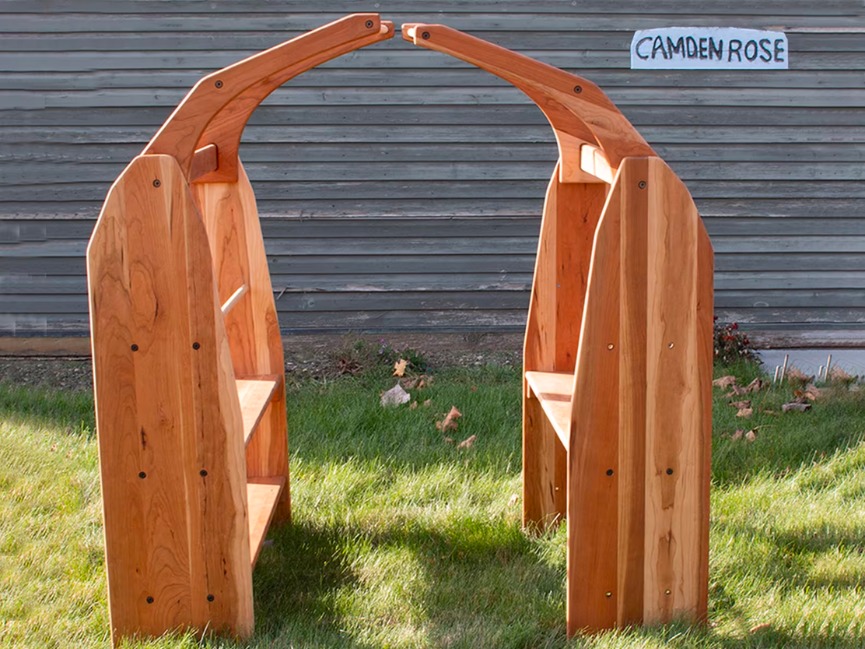
This Camden Rose playstand is a delightful blend of style and sustainability. Made from cherry wood and featuring smooth, rounded edges, this large playstand offers an eco-friendly option for your child’s play space.
The rich, warm hues of cherry wood make it an attractive addition to any room, and the ample shelving provides plenty of space for toys and games. The playstand is finished with beeswax and a food-grade mineral oil making it safe even for little ones that love to chew.
What we love:
the arch can be removed to use the stand as a shelf
- assembles in minutes
Play Stand for Toddler
This playstand for toddlers is a well-crafted, sturdy piece designed specifically for smaller children. It’s lower height and spacious shelves make it accessible and safe for young toddlers.
It is made from birch plywood, making it cheaper than some of the other playstands in this list. The simple design encourages open-ended play and can be used as a toy shelf, play kitchen, or small puppet theater.
What we love:
the low shelves
the spacious arch
- budget-friendly price
Mia Playhouse with Shop Insert
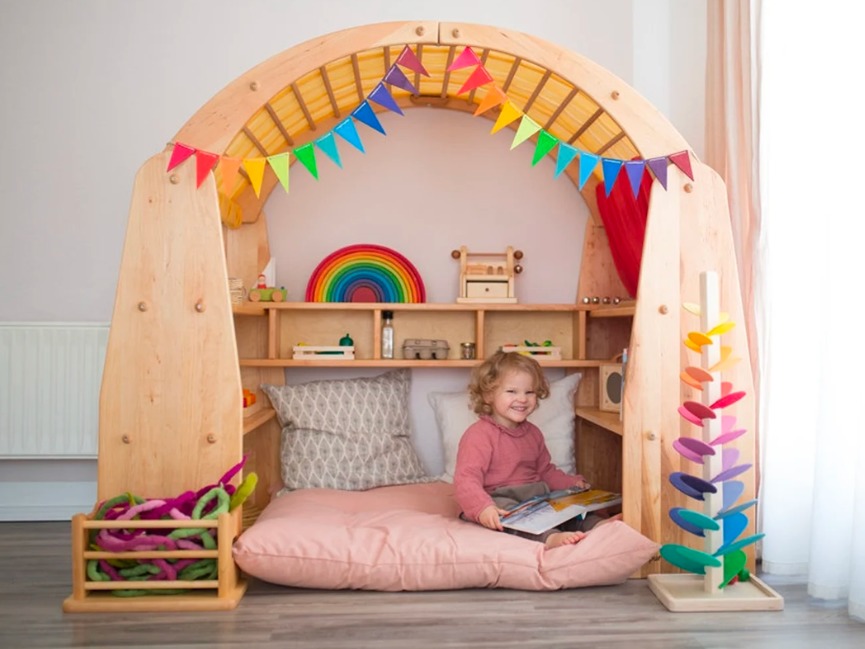
The Mia Playhouse is a multifunctional Waldorf playstand designed for imaginative play. With a shop insert included, it provides a great setup for pretend-play scenarios. The two halfs of the playstand can by used separately as shelves or set up together with the arch.
This playhouse can also be transformed into a cozy reading corner or an arts and crafts station. It is made from solid alder wood making it an extra durable piece that will last for years. The natural wood finish brings a sense of warmth and calm to any room.
What we love:
- the included shop insert add to play without being overly specific
Head Hands Heart Waldorf Playstand – One Side Only
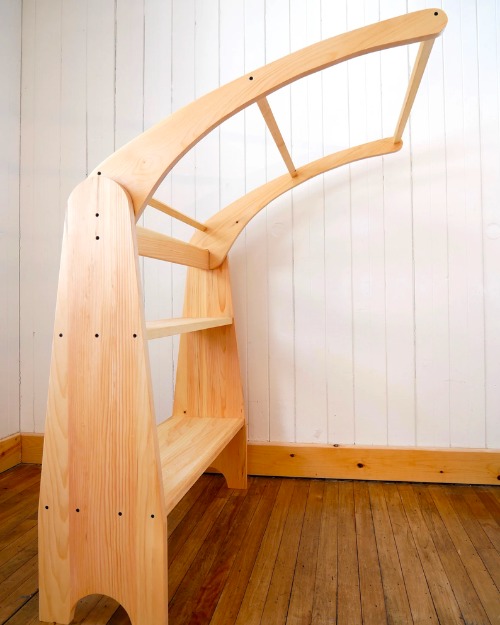
This one-sided playstand offers a versatile and compact option for smaller spaces. Its sturdy design and easy assembly make it an excellent choice. It is made from 100% natural pine wood and finished with natural Danish oil to help protect the wood.
It can be used on its own or paired with another stand for a more expansive play area.
What we love:
the single stand can be used in small spaces
Head Hands Heart Waldorf Space Divider
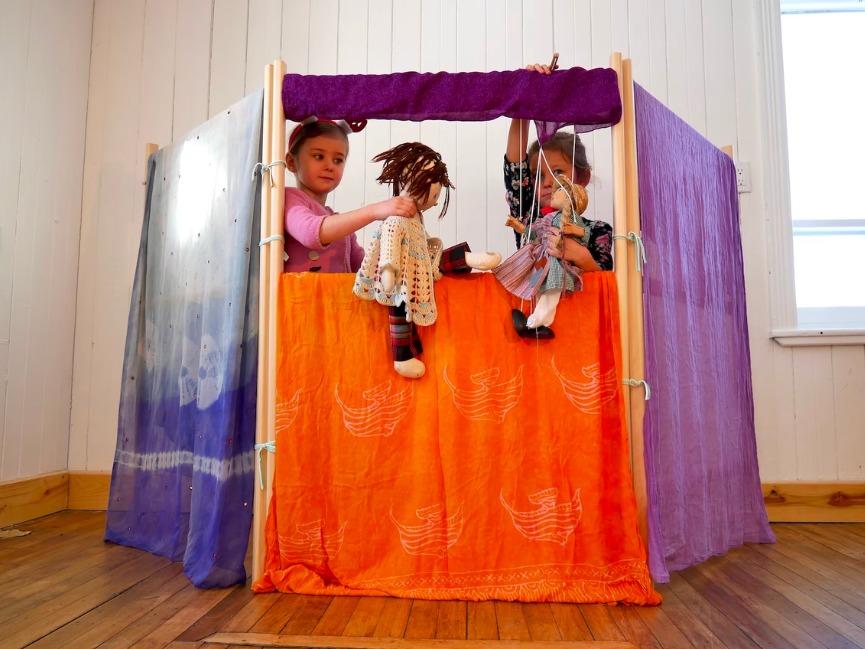
Waldorf space dividers are one of our favorite play items for kids! We have 10 space dividers in our classroom that are available for students to use.
Kids can easily pull them out and create varied forts and play areas using dividers, play silks, and play clips. We love watching the creative ways that kids use them on a daily basis.
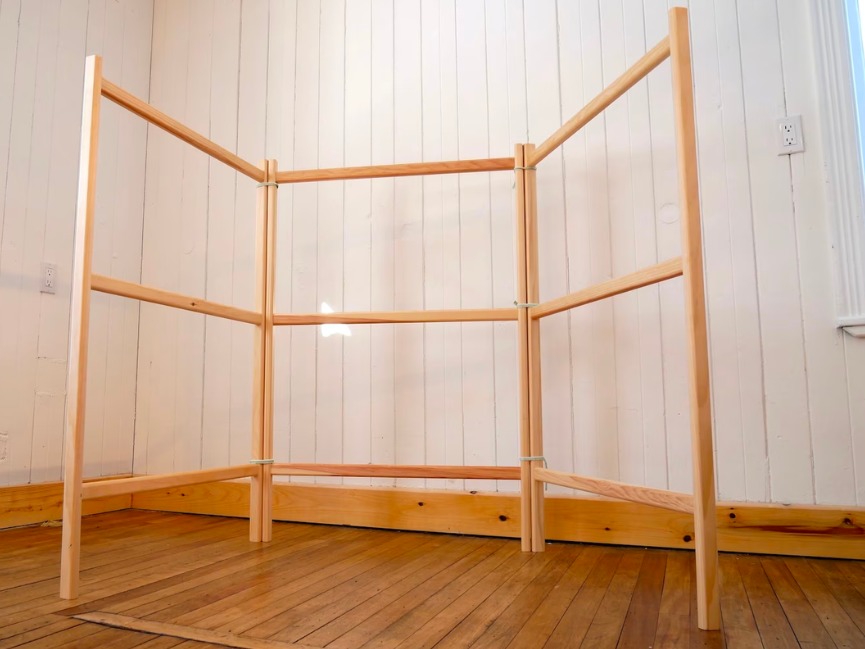
This simple Waldorf Space Divider is crafted with careful attention to detail and designed for durability and longevity. The play stand offers a host of imaginative play opportunities.
The space divider does need to be assembled when it arrives but it takes less than 20 minutes. Pieces of elastic are used to tie the frame together
What we love:
the dividers can be used in endless ways
the dividers are light enough for kids to move/use them independently
Buying Considerations
When selecting a Waldorf playstand, there are a few considerations to keep in mind:
Size: Make sure the playstand fits comfortably within your available space. If the room is small, opt for a one-sided or compact design so as not to take up too much of the play space.
Material: Waldorf philosophy prefers natural materials. Look for playstands made from solid, untreated woods like pine, birch, or cherry. These playstands will add beauty to a child’s space while also being of a quality that will last a long time.
Age appropriateness: If you’re buying for a toddler, ensure the playstand is low enough for them to reach and doesn’t have sharp corners.
Versatility: Choose a design that allows for a variety of play scenarios, like a stand with shelves or a canopy.
Assembly: Check if the playstand requires assembly and if so, whether it’s simple enough to do yourself.
Waldorf Playstand Accessories
Enhance your child’s play experience with these accessories:
- Waldorf Play Clips: These clips are designed to hold play scarves or fabric on playstands, enabling children to create imaginative play scenes. We love that kids can easily use them on their own and do not have to rely on help from adults.
Here are our favorite playclips. Play Scarves: Flowing, colorful scarves can transform a playstand into a puppet theater, a store, or a cozy den. We love Sarah’s Silks.
Play Kitchens: Play kitchens offer a fantastic role-play opportunity. Many playstands have enough space to accommodate a small play kitchen setup.
Remember, the Waldorf philosophy is about sparking imagination and learning through play. Any accessory you add should serve this purpose and add to your child’s creative experiences.
Select items that are as open-ended as possible to allow your kids to bring their own imagination to their play.
- Do you have a little climber who is going to scale a Waldorf playstand? Opt for a pikler triangle instead!
FAQs about Waldorf Playstands
1. What age is a Waldorf playstand suitable for?
Waldorf playstands are typically suitable for children ages 2 years and above. The open-ended nature of the playstand allows it to grow with your child, providing an engaging play area for many years. We have seen 10 and 12-year-olds still use their play stands for a cozy reading nook.
2. Can I use a Waldorf playstand outdoors?
While Waldorf playstands are primarily designed for indoor use, they can be used outdoors in dry, mild weather. However, to preserve the wood, they should be stored indoors when not in use.
3. Are Waldorf playstands safe?
Yes, Waldorf playstands are designed with children’s safety in mind. They are typically made from solid wood with rounded edges and corners to prevent injury. Always ensure the playstand is properly assembled and stable before letting children play with it.
Playstands are NOT meant for climbing and so kiddos who love to climb should be closely supervised.
4. How do I clean a Waldorf playstand?
Cleaning a Waldorf playstand typically involves wiping it down with a soft, damp cloth. Avoid using harsh chemicals or abrasive cleaning tools, as these can damage the wood.
5. How much space do I need for a Waldorf playstand?
The space required will depend on the size of the playstand. Always check the dimensions of the playstand before purchasing and ensure you have enough space in your home to accommodate it.
If you have a smaller space buying half of a playstand or a space divider might be the best option to allow room for play.
6. Can I build my own Waldorf playstand?
Yes, with the right skills and tools, you can build your own Waldorf playstand! You can purchase some DIY plans or create your own. Remember to ensure the finished product is safe and sturdy for your child to play with.
7. Why are Waldorf playstands usually made of wood?
The Waldorf philosophy emphasizes the use of natural materials in children’s toys and furniture. Wood is preferred for its warm, natural characteristics and for its strength and durability.The natural grain and textures of wood also provide a sensory experience for children.
8. What are the educational benefits of a Waldorf playstand?
Waldorf playstands promote imaginative, open-ended play, which is crucial for a child’s cognitive and social development. They encourage role-play, problem-solving, storytelling, and social interactions, all of which contribute to a child’s learning and growth.
Final Thoughts on Waldorf Playstands
Choosing a Waldorf playstand is more than just picking out a piece of furniture – it’s about investing in your child’s development. Rooted in a philosophy that prioritizes imagination, creativity, and respect for the natural world, these Waldorf playstands are a beacon for kids’ love of open-ended play.
They’re a testament to the fact that sometimes, the simplest toys, devoid of flashing lights and digital sounds, can provide the most engaging experiences.
Whether you’re new to the Waldorf philosophy or a long-time advocate, adding a Waldorf playstand to your house or playroom could help foster play and creativity in your kids.

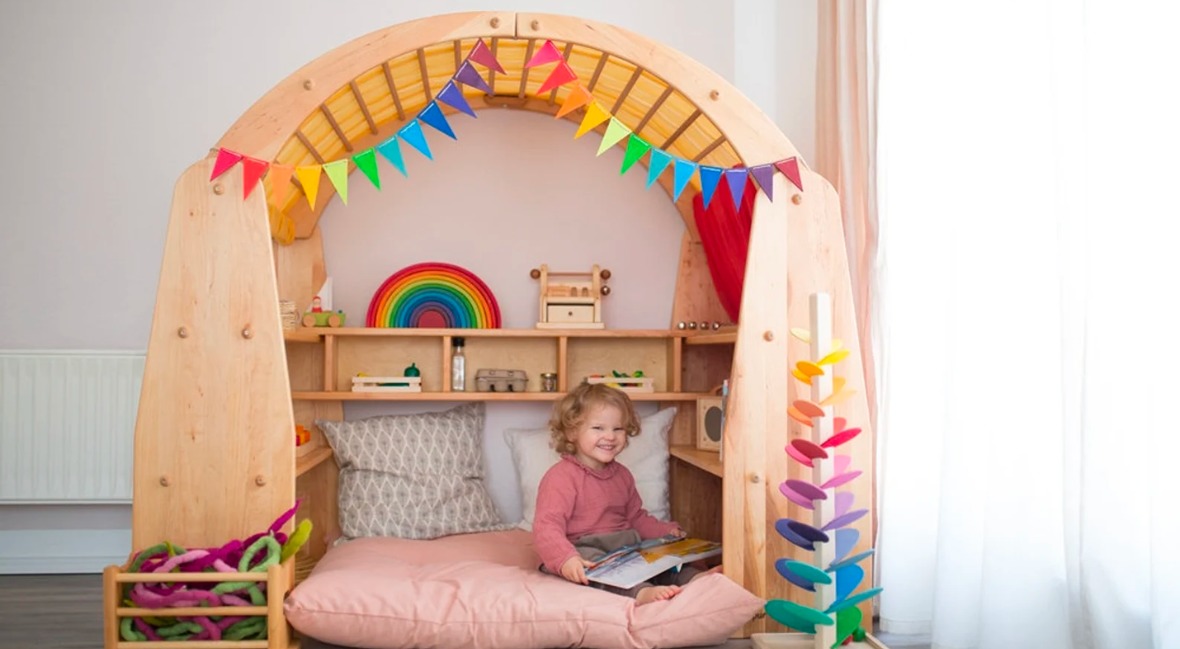
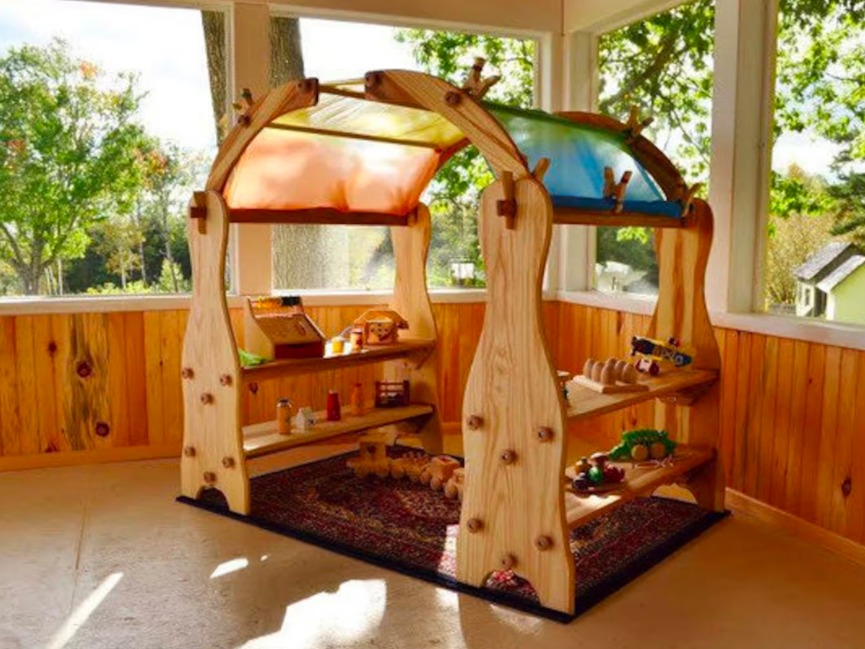

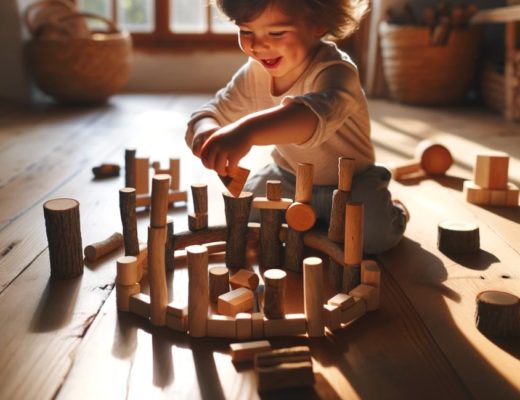

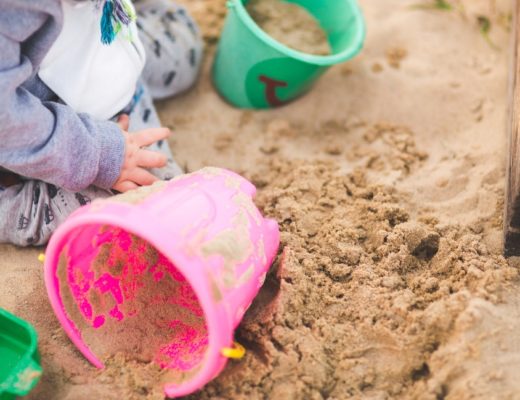
No Comments